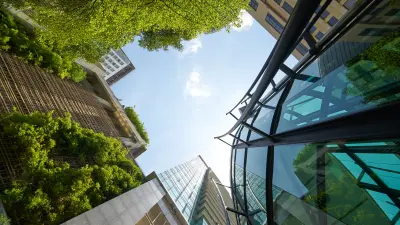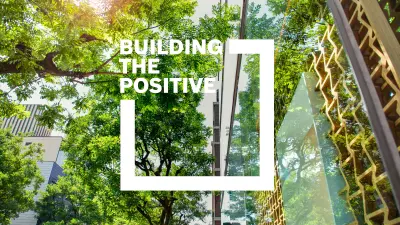“We have to get moving”
Which laws, requirements, and regulations on sustainability are now relevant to building managers? Christian Meysenburg, professor of real estate and facility management at SRH University Heidelberg, provides an overview.

Green deal, ESG, taxonomy, the EU regulation on sustainability-related disclosures – there’s a whole swarm of buzzwords around the current discussion of green building. Can you shine some light into this jungle of concepts?
At the metalevel we have the sustainable development goals of the United Nations, which were adopted back in 2015. They address the areas of environment, social, and governance, hence the acronym ESG. So they don’t just deal with environmental aspects. Achieving peace and alleviating poverty, for example, are also included. So you could say that the UN goals provide an overarching theoretical framework for the theme of sustainability. Of course, this begs the question as to how we should put it all into practice. That’s why the EU passed the Green Deal in 2020 with a clearly defined objective: for Europe to become climate-neutral. So it’s no longer just theory but an ambitious ongoing program. Among other things, the Green Deal aims at mobilizing industry to achieve a clean, “circular” economy. Energy- and resource-saving construction and renovation also play a role.

More and more companies will have to submit reports.
Who decides what is a sustainable investment?
Good question. The decision-making process naturally has to be defined, which brings us to the topic of taxonomy. You’re probably familiar with the debates on this from the press. France says that nuclear power plants are sustainable because otherwise theirs wouldn’t receive any more funding. And Germany, for its part, has insisted that gas-fired power plants have to be regarded as sustainable because they emit less carbon dioxide than coal-fired ones. Everyone has their own particular interests. But the EU sustainability taxonomy (Regulation 2020/852) sets binding rules on what does and doesn’t constitute a sustainable activity and which specific requirements companies have to meet.
And what exactly are these requirements?
The regulation defines six taxonomy goals in the “E” category (for environment). The first is to mitigate climate change and the second is to adapt to it. The third objective is sustainable use of water and marine resources, and the fourth is transitioning to a circular economy. The list concludes with the aims of preventing pollution and protecting biodiversity and ecosystems.
Since June 2023, all of the goals have been defined in considerable detail. Now there are specific regulations for different sectors. For the construction and real estate sector, for example, requirements have been defined for new buildings, renovations, and acquisition and ownership. Exactly which activities are required in each case, the goals they contribute to achieving, and the criteria they have to meet are regularly updated at Taxonomie-Kompass.
The general principle is that an economic activity can only be regarded as sustainable if makes a substantial positive contribution to achieving at least one environmental goal – and doesn’t interfere with any of the others. This is the principle of “do no significant harm” (DNSH). To illustrate it with an example: if a company, say, invests in sustainable real estate, that’s all fine and good – but it doesn’t actually accomplish anything if environmental goals are undermined in the actual buildings.
So this brings us to the topic of building optimization?
Correct. It’s absolutely essential to renovate buildings. In Germany this is for the most part already regulated by the Building Energy Act, and if you meet its requirements you’re on track to comply with the EU taxonomy. Reducing the need for primary energy by at least 30% is also seen as a substantial contribution to achieving the taxonomy goal of protecting the climate. Installing, servicing, and repairing measurement and control equipment naturally also boost energy efficiency. But let’s be clear: taxonomy compliance is useless if it’s counteracted by damage inflicted elsewhere.
This basically concerns all companies, right?
Yes, because companies don’t only need to stay fit for the future overall. They also have to make sure that their buildings retain their value over the long term. Nobody wants “stranded assets” in their portfolio – in other words, properties that have become a liability because they are no longer salable. So it’s not just about construction projects to erect new, climate-neutral “zero-emissions buildings.” The main focus is on the existing ones. Because the buildings that are supposed to be climate-neutral in the near future already exist – 85% of the buildings we’ll have in 2050 are standing today! This explains why facility management plays a crucial role in connection with the European Green Deal and taxonomy compliance. Those who are responsible for buildings are the ones that can make the greatest contribution to achieving the sustainability targets – namely, by reporting data and making improvements.
So what should the owners, operators, and facility managers of commercial and public buildings do now?
It basically boils down to three things. First of all, they should definitely address their company’s or organization’s sustainability activities. Every enterprise will have to develop an ESG strategy and demonstrate its sustainability in the context of the EU’s Green Deal and taxonomy. And here, as I already mentioned, buildings will have to account for the lion’s share. It’s important to ask, what can I accomplish right here in terms of increasing sustainability?
Second, they are well-advised to lay out a decarbonization path for each building – in other words, specific steps for reducing greenhouse gas emissions to zero by the specified deadlines. A good tool for doing this is the Carbon Risk Real Estate Monitor (CRREM) launched by the EU. It makes it very easy to assess and eliminate carbon risks. Like by investing in thermal insulation, replacing windows, or installing a new heating system. That’s what it’s about. Of course, it gets progressively harder to eliminate the last few percent of CO2. But one thing is clear: we have to go down this path and we have to start now.
This brings us to the third point: get going! Like I already mentioned, the EU wants climate neutrality by 2050 and the German Climate Protection Act is even aiming for 2045. In the real estate sector, that’s really not much time at all. The wheels of our planning processes turn slowly – it can take ages for something to be decided, approved within the company, cleared by the authorities, and eventually implemented. So take a hard look to see how you can improve your buildings’ energy efficiency and slash their emissions as soon as possible!
About
Prof. Dr.-Ing. Christian Meysenburg is an acknowledged expert on sustainable buildings and ESG strategies. He shares his knowledge as the head of the real estate and facility management degree program at SRH University Heidelberg while also serving as the managing director of the Meysenburg und Partner Ingenieure engineering firm and playing an active role in the ReaIFM and GEFMA facility management associations. His extensive practical experience enables him to provide expert advice to companies on the topics of real estate and sustainability.



